Comparing Artificial Intelligence Algorithms with Empirical Correlations in Shear Wave Velocity Prediction
Abstract
:1. Introduction
2. Data and Methods
2.1. Project Description
2.2. Well Logging Data
2.3. Methodology
2.3.1. Linear Regression (LR)
2.3.2. Empirical Correlations
2.3.3. MLR Analysis
2.3.4. GEP Method
3. Results
3.1. Empirical Correlations
3.2. MLR Method
3.3. GEP Method
4. Discussion
5. Conclusions
Author Contributions
Funding
Institutional Review Board Statement
Informed Consent Statement
Data Availability Statement
Acknowledgments
Conflicts of Interest
References
- Sundararajan, N.; Seshunarayana, T. Shear wave velocities in the estimation of earthquake hazard over alluvium in a seismically active region. J. Geol. Soc. India 2018, 92, 259–264. [Google Scholar] [CrossRef]
- Jamiolkowski, M. Role of geophysical testing in geotechnical site characterization. Soils Rocks 2012, 35, 117–137. [Google Scholar] [CrossRef]
- Anbazhagan, P.; Sitharam, T.G. Site characterization and site response studies using shear wave velocity. J. Sustain. Energy Environ. 2008, 10, 1–53. [Google Scholar]
- Li, X.Y.; Zhang, Y.G. Seismic reservoir characterization: How can multicomponent data help? J. Geophys. Eng. 2011, 8, 123. [Google Scholar] [CrossRef]
- Rezaee, M.R.; Ilkhchi, A.K.; Barabadi, A. Prediction of shear wave velocity from petrophysical data utilizing intelligent systems: An example from a sandstone reservoir of Carnarvon Basin, Australia. J. Pet. Sci. Eng. 2007, 55, 201–212. [Google Scholar] [CrossRef]
- Crampin, S.; McGonigle, R.; Bamford, D. Estimating crack parameters from observations of P-wave velocity anisotropy. Geophysics 1980, 45, 345–360. [Google Scholar] [CrossRef]
- Pugin, A.J.M.; Pullan, S.E.; Hunter, J.A.; Oldenborger, G.A. Hydrogeological prospecting using P-and S-wave landstreamer seismic reflection methods. Near Surf. Geophys. 2009, 7, 315–328. [Google Scholar] [CrossRef]
- Hedtmann, N.; Alber, M. Investigation of water-permeability and ultrasonic wave velocities of German Malm aquifer rocks for hydro-geothermal energy. In Proceedings of the ISRM European Rock Mechanics Symposium—EUROCK 2017, Ostrava, Czech Republic, 20–22 June 2017. [Google Scholar]
- Sharifi-Mood, M.; Olsen, M.J.; Gillins, D.T.; Mahalingam, R. Performance-based, seismically-induced landslide hazard mapping of Western Oregon. Soil Dyn. Earthq. Eng. 2017, 103, 38–54. [Google Scholar] [CrossRef]
- Ikeda, T.; Tsuji, T. Robust subsurface monitoring using a continuous and controlled seismic source. Energy Procedia 2017, 114, 3956–3960. [Google Scholar] [CrossRef]
- Peuchen, J.; De Ruijter, M.R.; Hospers, B.; Assen, R.L. Shear wave velocity integrated in offshore geotechnical practice. In Proceedings of the SUT Offshore Site Investigation and Geotechnics, London, UK, 26–28 November 2002. [Google Scholar]
- Hosseini, K.; Matthews, K.J.; Sigloch, K.; Shephard, G.E.; Domeier, M.; Tsekhmistrenko, M. SubMachine: Web-based tools for exploring seismic tomography and other models of Earth’s deep interior. Geochem. Geophys. Geosystems 2018, 19, 1464–1483. [Google Scholar] [CrossRef]
- Nejad, M.M.; Momeni, M.S.; Manahiloh, K.N. Shear wave velocity and soil type microzonation using neural networks and geographic information system. Soil Dyn. Earthq. Eng. 2018, 104, 54–63. [Google Scholar] [CrossRef]
- Pickett, G.R. Acoustic character logs and their applications information evaluation. J. Pet. Technol. 1963, 15, 659–667. [Google Scholar] [CrossRef]
- Carroll, R.D. The determination of the acoustic parameters of volcanic rocks from compressional velocity measurements. Int. J. Rock Mech. Min. Sci. Geomech. 1969, 6, 557–579. [Google Scholar] [CrossRef]
- Tosaya, C.; Nur, A.B. Effects of diagenesis and clays on compressional velocities in rocks. Geophys. Res. Lett. 1982, 9, 5–8. [Google Scholar] [CrossRef]
- Domenico, S.N. Rock lithology and porosity determination from shear and compressional wave velocity. Geophysics 1984, 49, 1188–1195. [Google Scholar] [CrossRef]
- Castagna, J.P.; Swan, H.W.; Foster, D.J. Framework for AVO gradient and intercept interpretation. Geophysics 1998, 63, 948–956. [Google Scholar] [CrossRef]
- Han, D.H.; Nur, A.; Morgan, D. Effects of porosity and clay content on wave velocities in sandstones. Geophysics 1986, 51, 2093–2107. [Google Scholar] [CrossRef]
- Eissa, E.A.; Kazi, A. Relation between static and dynamic Young’s moduli of rocks. Int. J. Rock Mech. Min. Sci. Geomech. Abstr. 1988, 25, 478–482. [Google Scholar] [CrossRef]
- Boonen, P.; Bean, C.; Tepper, R.; Deady, R. Important Implications from A Comparison of Lwd and Wireline Acoustic Data from A Gulf of Mexico Well. In Proceedings of the SPWLA 39th Annual Logging Symposium, Keystone, CO, USA, 26 May 1998. SPWLA-1998-S. [Google Scholar]
- Krief, M.; Garat, J.; Stellingwerff, J.; Ventre, J. A petrophysical interpretation using the velocities of P and S waves (full-waveform sonic). Log Anal. 1990, 31, 355–369. [Google Scholar]
- Anselmetti, F.S.; Eberli, G.P. Controls on sonic velocity in carbonates. Pure Appl. Geophys. 1993, 141, 287–323. [Google Scholar] [CrossRef]
- Yasar, E.; Erdogan, Y. Correlating sound velocity with the density, compressive strength, and Young’s modulus of carbonate rocks. Int. J. Rock Mech. Min. Sci. 2004, 41, 871–875. [Google Scholar] [CrossRef]
- Brocher, T.M. Empirical relations between elastic wavespeeds and density in the Earth’s crust. Bull. Seismol. Soc. Am. 2005, 95, 2081–2092. [Google Scholar] [CrossRef]
- Ameen, M.S.; Smart, B.G.; Somerville, J.M.; Hammilton, S.; Naji, N.A. Predicting rock mechanical properties of carbonates from wireline logs (A case study: Arab-D reservoir, Ghawar field, Saudi Arabia). Mar. Pet. Geol. 2009, 26, 430–444. [Google Scholar] [CrossRef]
- Wadhwa, R.S.; Ghosh, N.; Subba-Rao, C. Empirical relation for estimating shear wave velocity from compressional wave velocity of rocks. J. Indian Geophys. Union 2010, 14, 21–30. [Google Scholar]
- Rasouli, V.; Pallikathekathil, Z.J.; Mawuli, E. The influence of perturbed stresses near faults on drilling strategy: A case study in Blacktip field, North Australia. J. Pet. Sci. Eng. 2011, 76, 37–50. [Google Scholar] [CrossRef]
- Mehrad, M.; Ramezanzadeh, A.; Bajolvand, M.; Hajsaeedi, M.R. Estimating shear wave velocity in carbonate reservoirs from petrophysical logs using intelligent algorithms. J. Pet. Sci. Eng. 2022, 212, 110254. [Google Scholar] [CrossRef]
- Bagheripour, P.; Gholami, A.; Asoodeh, M.; Vaezzadeh-Asadi, M. Support vector regression based determination of shear wave velocity. J. Pet. Sci. Eng. 2015, 125, 95–99. [Google Scholar] [CrossRef]
- Behnia, D.; Ahangari, K.; Moeinossadat, S.R. Modeling of shear wave velocity in limestone by soft computing methods. Int. J. Min. Sci. Technol. 2017, 27, 423–430. [Google Scholar] [CrossRef]
- Wantland, D.; Laroque, G.E.; Bollo, M.F.; Dickey, D.D.; Goodman, R.E. Geophysical Measurements of Rock Properties In Situ. Available online: https://trid.trb.org/view/119270 (accessed on 29 October 2023).
- Christensen, N.I. Compressional wave velocities in possible mantle rocks to pressures of 30 kilobars. J. Geophys. Res. 1974, 79, 407–412. [Google Scholar] [CrossRef]
- Wong, K.W.; Fung, C.C.; Ong, Y.S.; Gedeon, T.D. Reservoir Characterization Using Support Vector Machines. In Proceedings of the International Conference on Computational Intelligence for Modelling, Control and Automation and International Conference on Intelligent Agents, Web Technologies and Internet Commerce (CIMCA-IAWTIC’06), Vienna, Austria, 28–30 November 2005. [Google Scholar] [CrossRef]
- Nagaraju, T.V.; Sireesha, M.; Sunil, B.M.; Alisha, S.S. A Review on Application of Soft Computing Techniques in Geotechnical Engineering. In Proceedings of the International Conference on Advances in Civil and Ecological Engineering Research, Macau, China, 4–7 July 2023; Springer Nature: Singapore, 2023; pp. 313–322. [Google Scholar] [CrossRef]
- Nagaraju, T.V.; Prasad, C.D.; Chaudhary, B.; Sunil, B.M. Assessment of Seismic Liquefaction of Soils Using Swarm-Assisted Optimization Algorithm. In Local Site Effects and Ground Failures: Select Proceedings of 7th ICRAGEE 2020; Springer: Singapore, 2021; pp. 295–304. [Google Scholar] [CrossRef]
- Nagaraju, T.V.; Prasad, C.D. Swarm-Assisted Multiple Linear Regression Models for Compression Index (Cc) Estimation of Blended Expansive Clays. Arab. J. Geosci. 2020, 13, 331. [Google Scholar] [CrossRef]
- Entezam, S.; Shokri, B.J.; Ardejani, S.D.; Mirzaghorbanali, A.; McDougall, K.; Aziz, N. Predicting the Pyrite Oxidation Process within Coal Waste Piles Using Multiple Linear Regression (MLR) and Teaching-Learning-Based Optimization (TLBO) Algorithm. Processes 2022, 10, 1–15. [Google Scholar]
- Fan, X.; Liu, B.; Luo, J.; Pan, K.; Han, S.; Zhou, Z. Comparison of Earthquake-Induced Shallow Landslide Susceptibility Assessment Based on Two-Category LR and KDE-MLR. Sci. Rep. 2023, 13, 833. [Google Scholar] [CrossRef]
- Pairojn, P.; Wasinrat, S. Earthquake Ground Motions Prediction in Thailand by Multiple Linear Regression Model. Electron. J. Geotech. Eng. 2015, 20, 12113–12124. [Google Scholar]
- Hui, G.; Gu, F.; Gan, J.; Saber, E.; Liu, L. An Integrated Approach to Reservoir Characterization for Evaluating Shale Productivity of Duvernary Shale: Insights from Multiple Linear Regression. Energies 2023, 16, 1639. [Google Scholar] [CrossRef]
- Rahmani-Rezaeieh, A.; Mohammadi, M.; Danandeh Mehr, A. Ensemble Gene Expression Programming: A New Approach for Evolution of Parsimonious Streamflow Forecasting Model. Theor. Appl. Climatol. 2020, 139, 549–564. [Google Scholar] [CrossRef]
- Mahdaviara, M.; Rostami, A.; Shahbazi, K. State-of-the-Art Modeling Permeability of the Heterogeneous Carbonate Oil Reservoirs Using Robust Computational Approaches. Fuel 2020, 268, 117389. [Google Scholar] [CrossRef]
- Tür, R. Maximum Wave Height Hindcasting Using Ensemble Linear-Nonlinear Models. Theor. Appl. Climatol. 2020, 141, 1151–1163. [Google Scholar] [CrossRef]
- Upom, M.R.A.; Alel, M.N.A.; Ab Kadir, M.A.; Yuzir, A. Prediction of Shear Wave Velocity in Underground Layers Using Particle Swarm Optimization. In IOP Conference Series: Materials Science and Engineering; IOP Publishing: Bristol, UK, 2019; Volume 527, p. 012012. [Google Scholar] [CrossRef]
- Ataee, O.; Hafezi Moghaddas, N.A.S.E.R.; Lashkari Pour, G.R.; Abbari Nooghabi, M.J. Predicting Shear Wave Velocity of Soil Using Multiple Linear Regression Analysis and Artificial Neural Networks. Sci. Iran. 2018, 25, 1943–1955. [Google Scholar] [CrossRef]
- Azar, J.H.; Javaherian, A.; Pishvaie, M.R. A Semi-Theoretical Approach to Determine Shear Wave Velocity Log Using MLR Method with a Hypothetical Test on Core and Well Log Data. In Proceedings of the 8th SEGJ International Symposium, Kyoto, Japan, 26–28 November 2006; Society of Exploration Geophysicists of Japan: Tokyo, Japan, 2006; pp. 1–6. [Google Scholar] [CrossRef]
- Shi, L.; Zhang, J. Prediction of Shear Wave Velocity Using Machine Learning Technique, Multiple Regression, and Well Logs. In Proceedings of the ARMA/DGS/SEG International Geomechanics Symposium, 1–4 November 2021. [Google Scholar]
- Guo, S.; Zhang, Y.; Iraji, A.; Gharavi, H.; Deifalla, A.F. Assessment of rock geomechanical properties and estimation of wave velocities. Acta Geophys. 2023, 71, 649–670. [Google Scholar] [CrossRef]
- Güllü, H. On the Prediction of Shear Wave Velocity at Local Site of Strong Ground Motion Stations: An Application Using Artificial Intelligence. Bull. Earthq. Eng. 2013, 11, 969–997. [Google Scholar] [CrossRef]
- Khazaei, I.; Shamekhi Amiri, M.; Bazrafshan Moghaddam, A. Prediction of Shear Wave Velocity and Soil Type of the Region with Recorded Accelerometer in Iran Plateau Using Vertical and Horizontal Seismic Components Spectral Ratios. J. Struct. Constr. Eng. 2022, 9, 201–222. [Google Scholar] [CrossRef]
- James, G.A.; Wynd, J.G. Stratigraphic nomenclature of Iranian oil consortium agreement area. AAPG Bull. 1965, 49, 2182–2245. [Google Scholar] [CrossRef]
- Sadooni, F.N. Stratigraphic Sequence, Microfacies, and Petroleum Prospects of the Yamama Formation, Lower Cretaceous, Southern Iraq. AAPG Bull. 1993, 77, 1971–1988. [Google Scholar] [CrossRef]
- Knez, D.; Khalilidermani, M.; Zamani, M.A.M. Water Influence on the Determination of the Rock Matrix Bulk Modulus in Reservoir Engineering and Rock-Fluid Coupling Projects. Energies 2023, 16, 1769. [Google Scholar] [CrossRef]
- Zamani, M.A.M.; Knez, D. Experimental Investigation on the Relationship between Biot’s Coefficient and Hydrostatic Stress for Enhanced Oil Recovery Projects. Energies 2023, 16, 4999. [Google Scholar] [CrossRef]
- Khanlari, G.R.; Heidari, M.; Momeni, A.A.; Abdilor, Y. Prediction of shear strength parameters of soils using artificial neural networks and multivariate regression methods. Eng. Geol. 2012, 131, 11–18. [Google Scholar] [CrossRef]
- Habibi, M.J.; Mokhtari, A.R.; Baghbanan, A.; Namdari, S. Prediction of permeability in dual fracture media by multivariate regression analysis. J. Pet. Sci. Eng. 2014, 120, 194–201. [Google Scholar] [CrossRef]
- Granian, H.; Tabatabaei, S.H.; Asadi, H.H.; Carranza, E.J.M. Multivariate regression analysis of lithogeochemical data to model subsurface mineralization: A case study from the Sari Gunay epithermal gold deposit, NW Iran. J. Geochem. Explor. 2015, 148, 249–258. [Google Scholar] [CrossRef]
- Ferreira, C. Gene expression programming: A new adaptive algorithm for solving problems. Complex Syst. 2001, 13, 87–129. [Google Scholar] [CrossRef]
- Li, X.; Zhou, C.; Nelson, P.C.; Tirpak, T.M. Investigation of constant creation techniques in the context of gene expression programming. LNCS 2004, 3103, 1–12. [Google Scholar]
- Mitchell, M. An Introduction to Genetic Algorithms; MIT Press: Cambridge, MA, USA; London, UK, 1996. [Google Scholar]
- Faradonbeh, S.R.; Armaghani, D.J.; Majid, M.A.; Tahir, M.M.; Murlidhar, B.R.; Monjezi, M.; Wong, H.M. Prediction of ground vibration due to quarry blasting based on gene expression programming: A new model for peak particle velocity prediction. Int. J. Environ. Sci. Technol. 2016, 13, 1453–1464. [Google Scholar] [CrossRef]
- Ferreira, C. Gene Expression Programming: Mathematical Modeling by an Artificial Intelligence, 2nd ed.; Springer: London, UK, 2006. [Google Scholar]
- Domingos, P. The Role of Occam’s Razor in Knowledge Discovery. Data Min. Knowl. Discov. 1999, 3, 409–425. [Google Scholar] [CrossRef]
- Sammut, C.; Webb, G.I. (Eds.) Encyclopedia of Machine Learning; Springer Science & Business Media: Berlin/Heidelberg, Germany, 2011. [Google Scholar]
- Shi, M.; Hu, W.; Li, M.; Zhang, J.; Song, X.; Sun, W. Ensemble Regression Based on Polynomial Regression-Based Decision Tree and Its Application in the In-Situ Data of Tunnel Boring Machine. Mech. Syst. Signal Process. 2023, 188, 110022. [Google Scholar] [CrossRef]
- Ghasemi, M.; Samadi, M.; Soleimanian, E.; Chau, K.W. A Comparative Study of Black-Box and White-Box Data-Driven Methods to Predict Landfill Leachate Permeability. Environ. Monit. Assess. 2023, 195, 862. [Google Scholar] [CrossRef]
- Shafagh Loron, R.; Samadi, M.; Shamsai, A. Predictive Explicit Expressions from Data-Driven Models for Estimation of Scour Depth Below Ski-Jump Bucket Spillways. Water Supply 2023, 23, 304–316. [Google Scholar] [CrossRef]
- Rajabi, M.; Bohloli, B.; Ahangar, E.G. Intelligent approaches for prediction of compressional, shear, and Stoneley wave velocities from conventional well log data: A case study from the Sarvak carbonate reservoir in the Abadan Plain (Southwestern Iran). Comput. Geosci. 2010, 36, 647–664. [Google Scholar] [CrossRef]
- Ghorbani, A.; Jafarian, Y.; Maghsoudi, M.S. Estimating shear wave velocity of soil deposits using polynomial neural networks: Application to liquefaction. Comput. Geosci. 2012, 44, 86–94. [Google Scholar] [CrossRef]
- Anemangely, M.; Ramezanzadeh, A.; Tokhmechi, B. Shear wave travel time estimation from petrophysical logs using ANFIS-PSO algorithm: A case study from Ab-Teymour Oilfield. J. Nat. Gas Sci. Eng. 2017, 38, 373–387. [Google Scholar] [CrossRef]
- Knez, D.; Zamani, O.A.M. Up-to-Date Status of Geoscience in the Field of Natural Hydrogen with Consideration of Petroleum Issues. Energies 2023, 16, 6580. [Google Scholar] [CrossRef]
- Agofack, N.; Cerasi, P.; Sønstebø, E.; Stenebråten, J. Thermo-Poromechanical Properties of Pierre II Shale. Rock Mech. Rock Eng. 2022, 55, 6703–6722. [Google Scholar] [CrossRef]
- Lion, M.; Skoczylas, F.; Ledésert, B. Effects of heating on the hydraulic and poroelastic properties of bourgogne limestone. Int. J. Rock Mech. Min. Sci. 2005, 42, 508–520. [Google Scholar] [CrossRef]
- Yin, H.; Zhang, G.; Wu, Q.; Yin, S.; Soltanian, M.R.; Thanh, H.V.; Dai, Z. A Deep Learning-Based Data-Driven Approach for Predicting Mining Water Inrush from Coal Seam Floor Using Micro-seismic Monitoring Data. IEEE Trans. Geosci. Remote Sens. 2023, 61, 1. [Google Scholar] [CrossRef]
- Bauer, E.; Kohavi, R. An Empirical Comparison of Voting Classification Algorithms: Bagging, Boosting, and Variants. Mach. Learn. 1999, 36, 105–139. [Google Scholar] [CrossRef]
- Dietterich, T.G. An Experimental Comparison of Three Methods for Constructing Ensembles of Decision Trees: Bagging, Boosting, and Randomization. Mach. Learn. 2000, 40, 139–157. [Google Scholar] [CrossRef]
- Khalilidermani, M.; Knez, D. A Survey on the Shortcomings of the Current Rate of Penetration Predictive Models in Petroleum Engineering. Energies 2023, 16, 4289. [Google Scholar] [CrossRef]
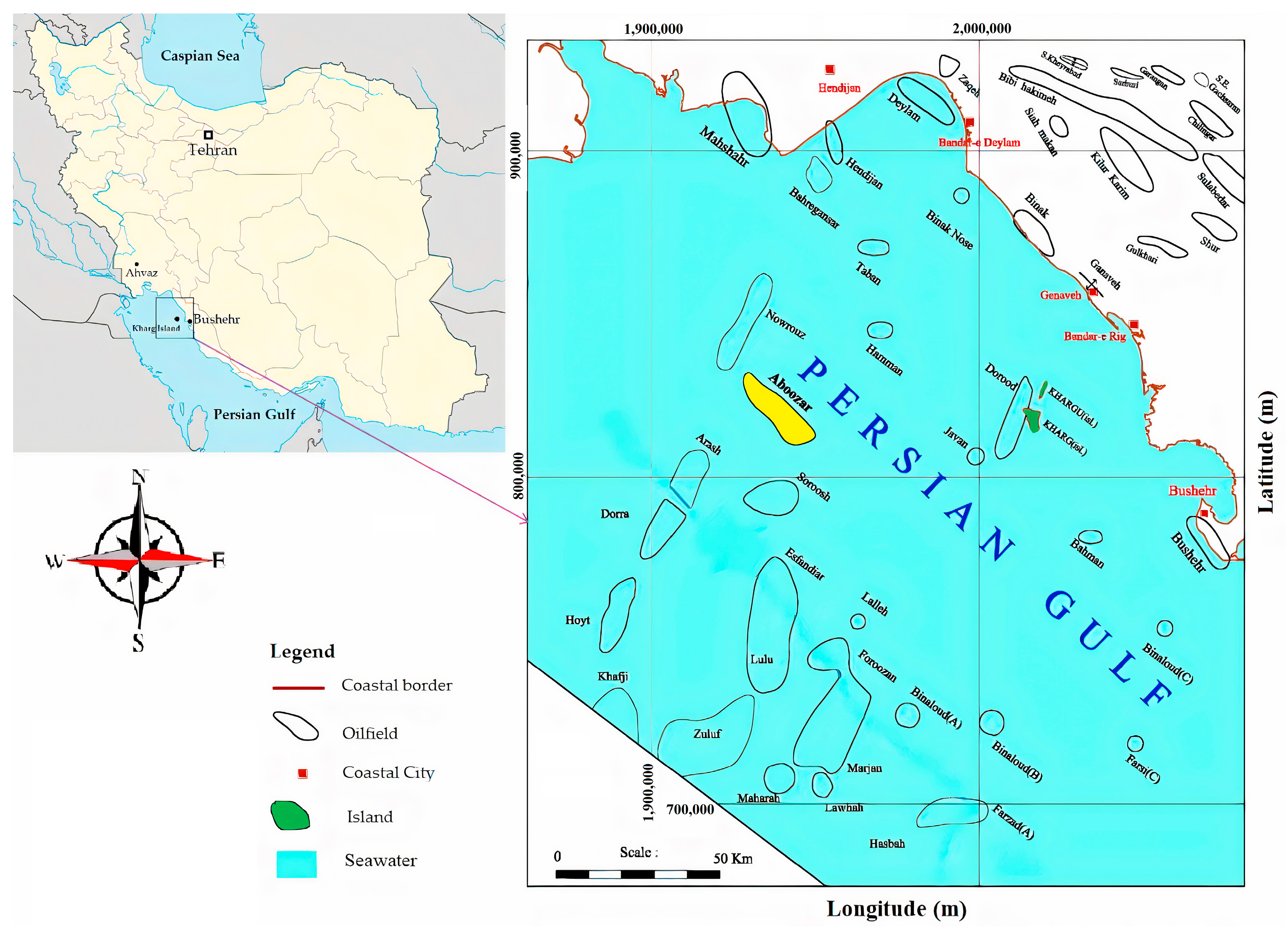
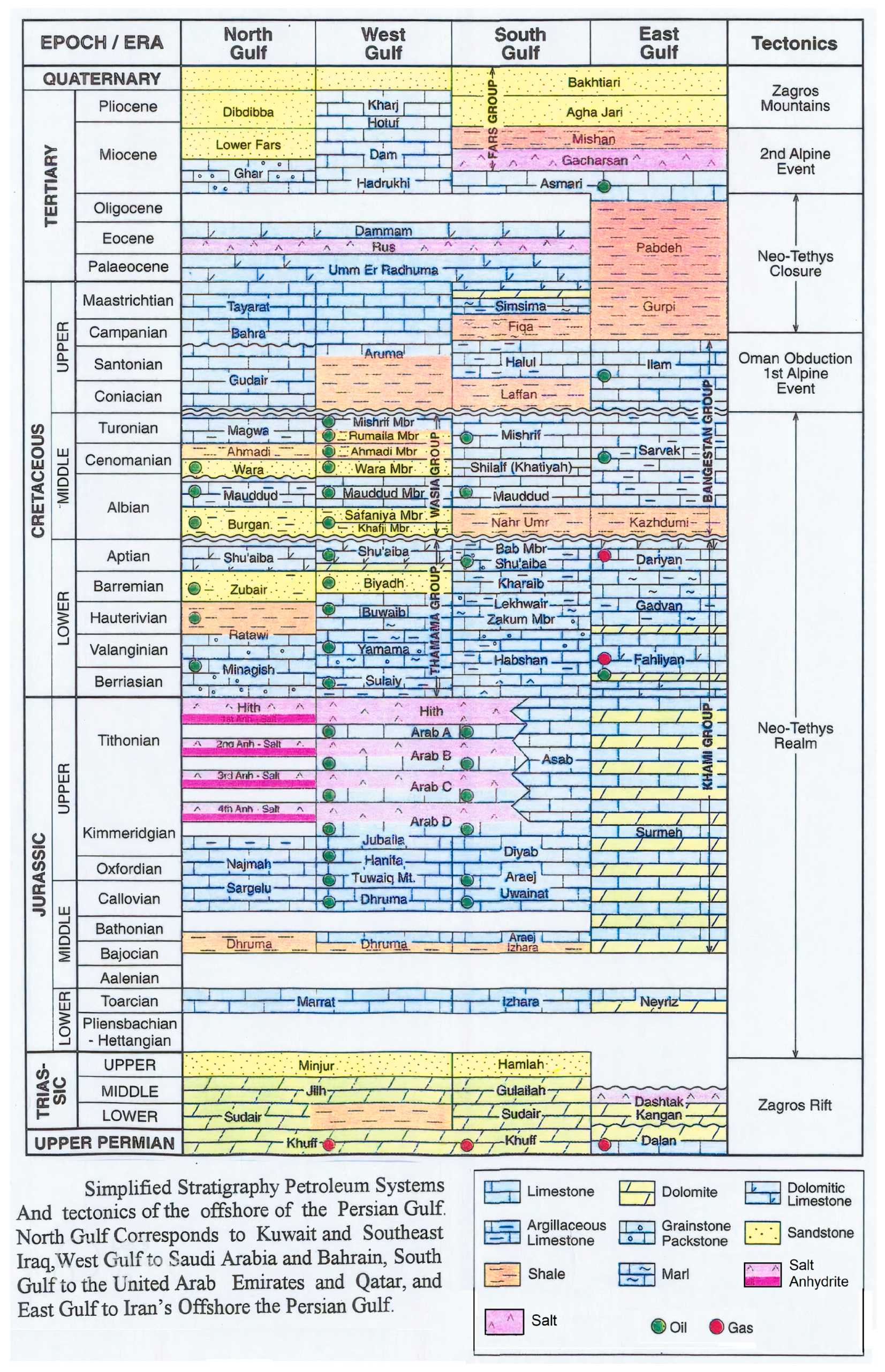
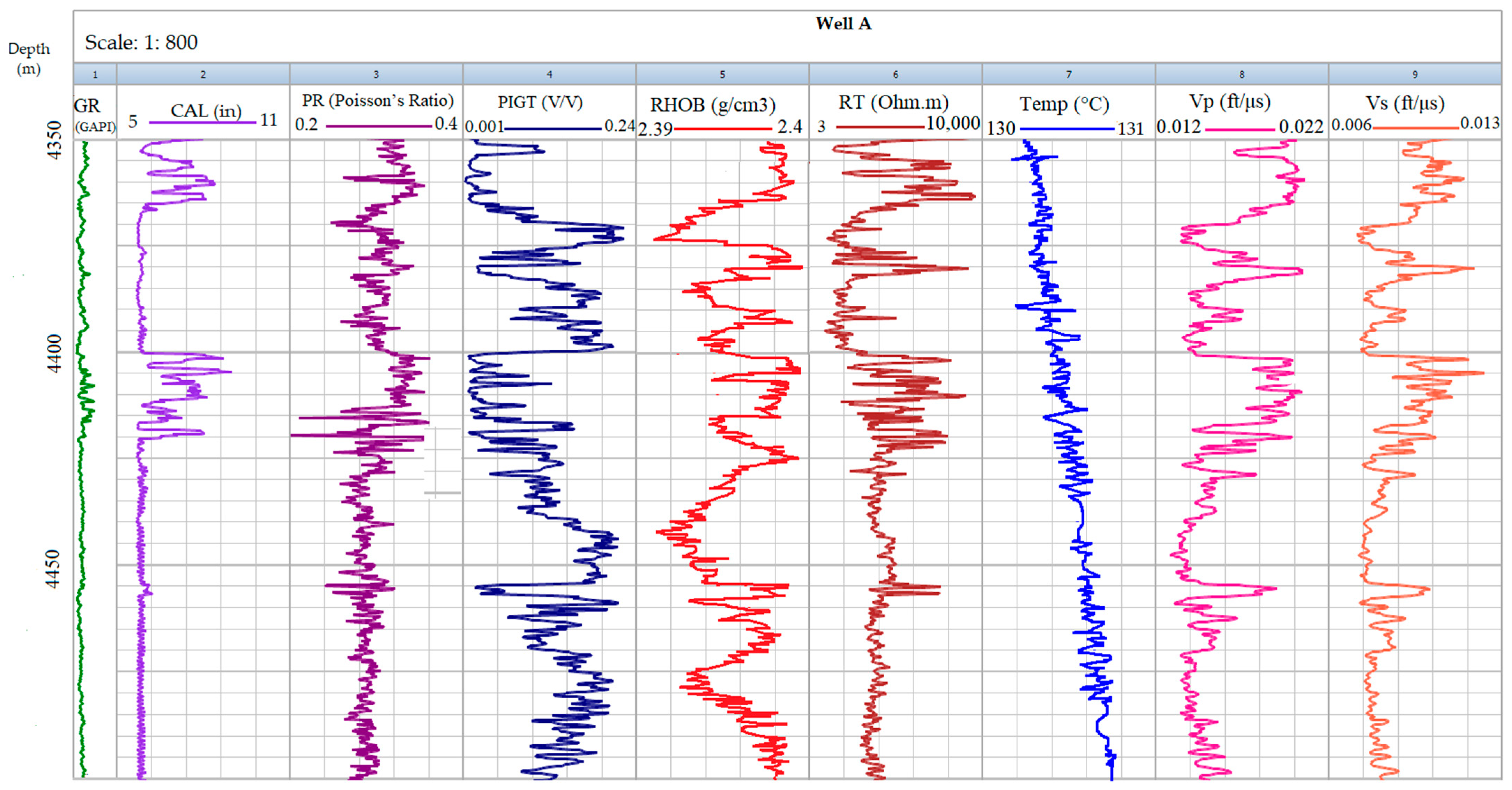

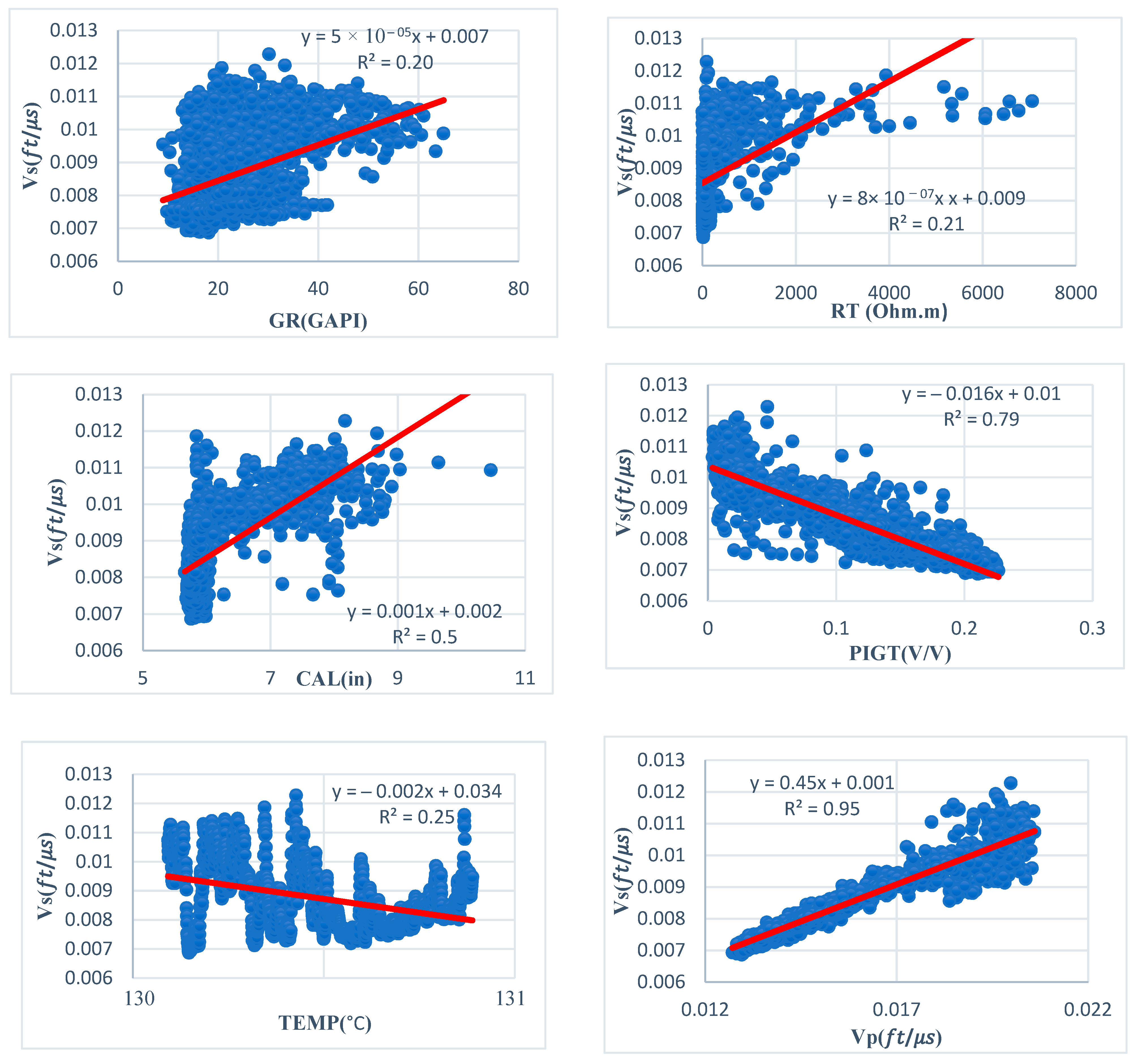




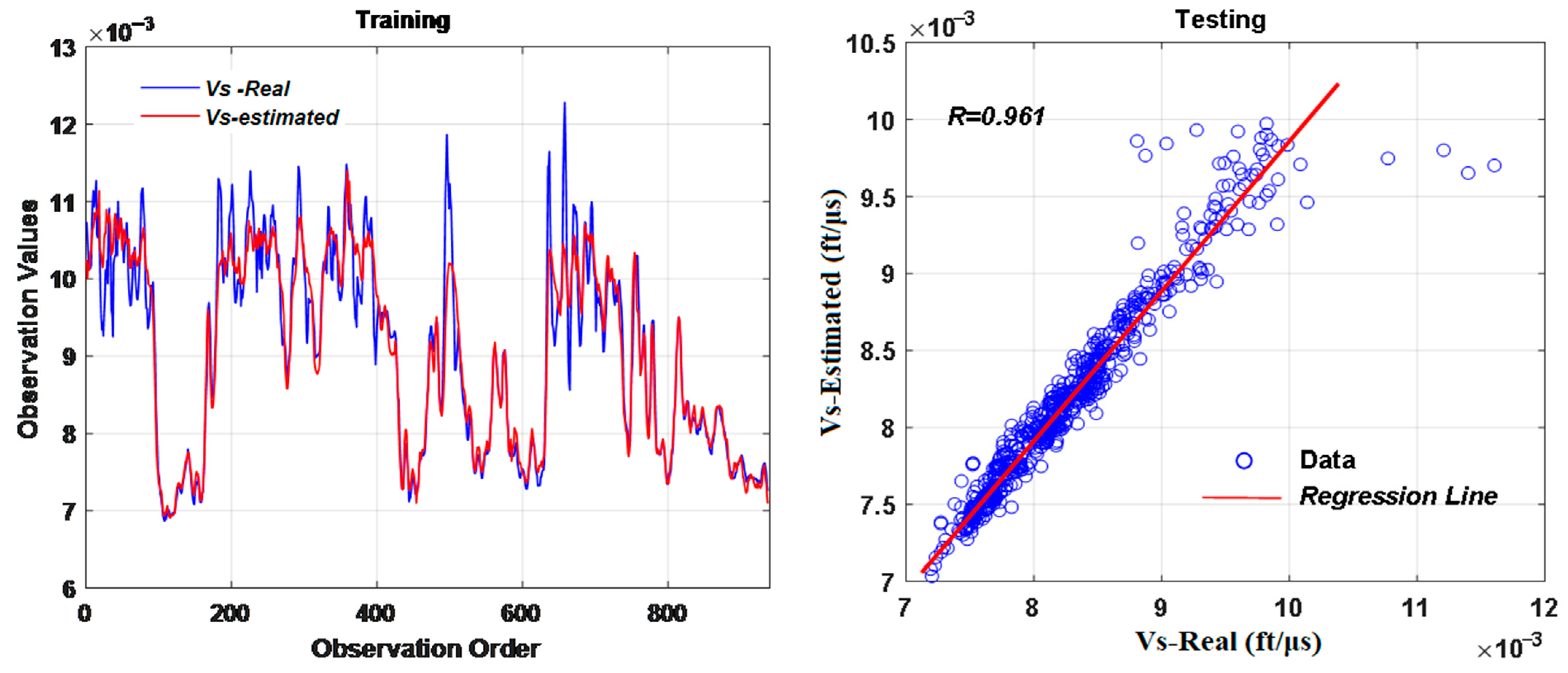



| Measurement Method | Advantages | Disadvantages |
|---|---|---|
| Laboratory Core Analysis | Provides accurate measurements. Allows detailed core sample analysis. Offers insights into rock properties. | Expensive and time-consuming. Limited to a small number of samples. May not replicate in situ conditions. |
| Geophysical Well Logging and In Situ Measurements | Provides direct measurements. Suitable for real-time well logging. | Limited to borehole locations. Tools and data acquisition can be costly. |
| Empirical and Correlation-Based Methods | Simplicity and ease of application. Uses readily available well log data. | Limited accuracy, relying on correlations. Applicability may be region-specific. |
| Theoretical and Physics-Based Models | Consider physical properties. Provides insights into rock behavior. | Complex and data-intensive. Requires a wide range of input parameters. |
| Data-Driven and Machine Learning Techniques | Handles complex data. Learning from diverse datasets. | Needs extensive, high-quality training data. Models may not always be interpretable. |
| Seismic and Geostatistical Approaches | Provides large-scale estimations. Characterization beyond wellbore. | Limited to seismic data availability. Inversion and modeling can be computationally intensive. |
| Correlation | Formula | Units | |
|---|---|---|---|
| Castagna et al., 1998 [18] | (2) | () and () | |
| Carroll, 1969 [15] | (3) | () and () | |
| Wadhwa et al., 2010 [27] | (4) | () and () | |
| Pickett, 1963 [14] | (5) | () and () | |
| Anselmetti and Eberli, 1993 [23] | (6) | (m/s); is density (g/cm3) | |
| Method | |||
|---|---|---|---|
| Castagna et al., 1998 [18] | 0.49 | 1.02261 | 1.02161 |
| Carroll, 1969 [15] | 0.68 | 0.02358 | 0.02343 |
| Wadhwa et al., 2010 [27] | 0.67 | 0.01642 | 0.01627 |
| Pickett, 1963 [14] | 0.95 | 0.00042 | 0.00032 |
| Anselmetti and Eberli, 1993 [23] | 0.35 | 0.00825 | 0.00816 |
| Dataset | Input Parameters | |||
|---|---|---|---|---|
| Dataset 1 | and | 0.95 | 0.000986 | 0.000893 |
| Dataset 2 | , , and | 0.96 | 0.000976 | 0.000899 |
| Dataset 3 | , , , and | 0.96 | 0.000993 | 0.000954 |
| Dataset 4 | , , , , and | 0.96 | 0.000969 | 0.000891 |
| Dataset 5 | , , , , , and | 0.96 | 0.000969 | 0.000910 |
| Dataset 6 | , , , , , , and | 0.96 | 0.000310 | 0.000252 |
| Dataset 7 | , , , , , , , and | 0.96 | 0.000881 | 0.000764 |
| Parameter | Unit | Coefficient | Range |
|---|---|---|---|
| () | 0.456290 | 0.0127–0.0205 | |
| - | −0.000726 | 0.0036–0.2340 | |
| in | 0.000141 | 5.6562–10.5145 | |
| - | −0.003617 | 0.2121–0.3745 | |
| Ω·m | 0.000001 | 0.5456–7200 | |
| GAPI | −0.000005 | 9.0195–65.0151 | |
| g/cm3 | 0.119900 | 2.3955–2.3400 |
| Training/Testing Ratio (%) | (Train) | (Test) | (Train) | (Test) | (Train) | (Test) |
|---|---|---|---|---|---|---|
| 90/10 | 0.961 | 0.886 | 0.000323 | 0.000317 | 0.000212 | 0.000235 |
| 80/20 | 0.960 | 0.917 | 0.000342 | 0.000283 | 0.000231 | 0.000207 |
| 70/30 | 0.956 | 0.947 | 0.000366 | 0.000218 | 0.000235 | 0.000198 |
| 60/40 | 0.956 | 0.958 | 0.000371 | 0.000231 | 0.000205 | 0.000175 |
| 50/50 | 0.944 | 0.960 | 0.000418 | 0.000277 | 0.000328 | 0.000201 |
| Dataset | Input Parameters | (Train) | (Test) | (Train) | (Test) | (Train) | (Test) |
|---|---|---|---|---|---|---|---|
| Dataset 1 | and | 0.954 | 0.958 | 0.000378 | 0.000243 | 0.000234 | 0.000198 |
| Dataset 2 | , , and | 0.954 | 0.958 | 0.000379 | 0.000239 | 0.000261 | 0.000186 |
| Dataset 3 | , , , and | 0.960 | 0.961 | 0.000355 | 0.000199 | 0.000221 | 0.000132 |
| Dataset 4 | , , , , and | 0.958 | 0.965 | 0.000364 | 0.000207 | 0.000242 | 0.000165 |
| Dataset 5 | , , , , , and | 0.954 | 0.960 | 0.000382 | 0.000195 | 0.000268 | 0.000141 |
| Dataset 6 | , , , , , , and | 0.958 | 0.961 | 0.000362 | 0.000224 | 0.000259 | 0.000163 |
| Dataset 7 | , , , , , , , and | 0.956 | 0.958 | 0.000371 | 0.000231 | 0.000263 | 0.000184 |
| Method | |||
|---|---|---|---|
| GEP | 0.972 | 0.000290 | 0.000208 |
Disclaimer/Publisher’s Note: The statements, opinions and data contained in all publications are solely those of the individual author(s) and contributor(s) and not of MDPI and/or the editor(s). MDPI and/or the editor(s) disclaim responsibility for any injury to people or property resulting from any ideas, methods, instructions or products referred to in the content. |
© 2023 by the authors. Licensee MDPI, Basel, Switzerland. This article is an open access article distributed under the terms and conditions of the Creative Commons Attribution (CC BY) license (https://creativecommons.org/licenses/by/4.0/).
Share and Cite
Khalilidermani, M.; Knez, D. Comparing Artificial Intelligence Algorithms with Empirical Correlations in Shear Wave Velocity Prediction. Appl. Sci. 2023, 13, 13126. https://doi.org/10.3390/app132413126
Khalilidermani M, Knez D. Comparing Artificial Intelligence Algorithms with Empirical Correlations in Shear Wave Velocity Prediction. Applied Sciences. 2023; 13(24):13126. https://doi.org/10.3390/app132413126
Chicago/Turabian StyleKhalilidermani, Mitra, and Dariusz Knez. 2023. "Comparing Artificial Intelligence Algorithms with Empirical Correlations in Shear Wave Velocity Prediction" Applied Sciences 13, no. 24: 13126. https://doi.org/10.3390/app132413126





